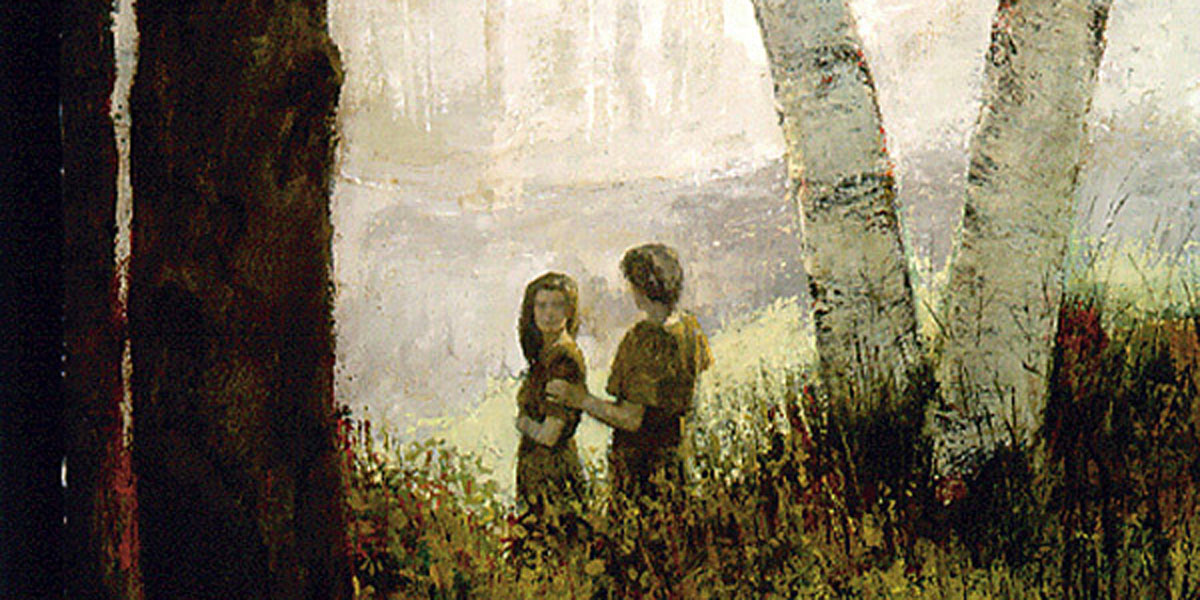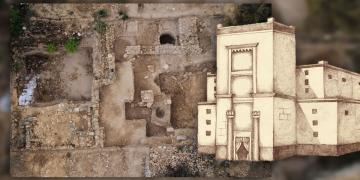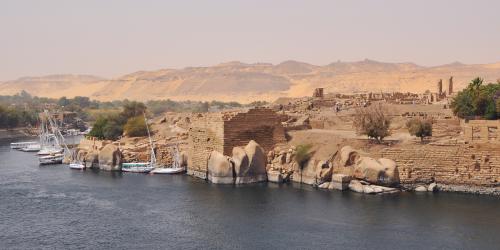You are here
Book of Mormon Central is in the process of migrating to our new Scripture Central website.
We ask for your patience during this transition. Over the coming weeks, all pages of bookofmormoncentral.org will be redirected to their corresponding page on scripturecentral.org, resulting in minimal disruption.
Come Follow Me 2020: 2 Nephi 1-5

Scripture Block
2 Nephi 1-5
February 3-9. “We Lived after the Manner of Happiness”
KnoWhys
Recommended Resources
Learn about the Book of Mormon with verse by verse commentaries from renowned Book of Mormon scholars like John W. Welch and Brant A. Gardner in the ScripturePlus app. Read this week's KnoWhy connected with the Come Follow Me curriculum, and watch a video elucidating an insight in this week's scripture reading.
Reading Plan
Structure your personal scripture study by following a multimedia, day by day plan. Each day's assignment includes the required scripture passages from the Come Follow Me curriculum, as well as suggestions for additional resources to bring context and understanding to your study. If you are looking to dive deep into your study, skip down to "Additional Resources" for a selected bibliography of articles, books, and chapters on 2 Nephi 1–5.
Monday
- 2 Nephi 1:1–32
- Video: Where is the Land of Promise?
- KnoWhy 378: What Does the Book of Mormon Say about the Armor of God?
Tuesday
- 2 Nephi 2:1–16
- Video: How the Book of Mormon and the Old Testament Help Us Understand What it Means to be Redeemed
- KnoWhy 400: Why Do We Have Three Different Accounts of the Creation?
Explore Further
- KnoWhy 436: How the Book of Mormon and the Old Testament Help Us Understand What it Means to be Redeemed
Wednesday
- 2 Nephi 2:17–30
- KnoWhy 28: What are the Origins of Lehi's Understanding of the Fall?
- Chart: Why Did Lehi Teach that the Fall was Necessary?
- Chart: Why Did Lehi Teach About the “Two Ways”?
Explore Further
- KnoWhy 43: Why Did Lehi "Suppose" the Existence of Satan?
- KnoWhy 269: Why Did Lehi Teach that the Fall was Necessary?
- KnoWhy 287: Why Did Lehi Teach About the “Two Ways”?
Thursday
- 2 Nephi 3:1–25
- KnoWhy 418: How Lehi Likened the Scriptures to Himself
- Quote: “Joseph in Egypt knew that the latter-day seer would bear his same name and the same name as his own father. Interestingly, the common practice in early America was for the first son to be named after the father, but the first two sons born to Joseph Sr. and Lucy Mack Smith were Alvin and Hyrum, reserving the name Joseph for the third son, thus unknowingly fulfilling an ancient prophecy.” Ogden, D. Kelly, and Andrew C. Skinner. Verse by Verse: The Book of Mormon. Salt Lake City, UT: Deseret Book, 2011.
- Quote: “Approximately 3,500 years before the birth of Joseph Smith, the prophet Joseph of Egyptian fame prophesied that in the latter days God would raise up a great prophet, seer, and revelator. This prophet and seer would perform a great and marvelous work for the salvation of the human family. His name would be Joseph, and his father's name would be Joseph . . . The Prophet Joseph Smith fits in every detail with the prophecy made anciently by Joseph of Egypt. Joseph Smith was God's holy anointed prophet, seer, and revelator through whom the gospel was revealed from heaven and the true Church of Jesus Christ established in the latter days in fulfillment of the predictions made by many of the ancient prophets. In every respect Joseph Smith was God's prophet, seer, and revelator who was 'great like unto Moses.'" Hunter, Milton R. “A Prophet ‘Great Like Unto Moses.'” General Conference October 1968.
- Image: Joseph Smith's Birth Foretold
Friday
- 2 Nephi 4:1–35
- Quote 280: "If reading the scriptures is not already a habit with you, today is a great day to start ... [J]oy has come from the habit of daily scripture reading which I started so many years ago. Some days I have a lot of time to contemplate the scriptures. Other days I reflect on a few verses. Just as eating and breathing sustain my physical body, the scriptures feed and give life to my spirit. I can now echo Nephi and say: 'My soul delighteth in the scriptures, and my heart pondereth them. … Behold, my soul delighteth in the things of the Lord; and my heart pondereth continually upon the things which I have seen and heard.'" Beck, Julie B. "My Soul Delighteth in the Scriptures." General Conference April 2004.
- Quote 283: "Rationalization is the intellectual drug that anesthetizes the sting of conscience. Mormon witnessed this deadly overdose at the time his people were 'without principle, and past feeling.' Nephi saw the danger signals in the lives of Laman and Lemuel when he noted, '[God] hath spoken unto you in a still small voice, but ye were past feeling.' Contrast that with Nephi's lamentation: 'O wretched man that I am! … My heart groaneth because of my sins; nevertheless, I know in whom I have trusted.' It is hard to imagine those words from a prophet of God. Nephi's life was one of devotion and obedience, yet he was ever more conscious of the distance still to be traveled for perfection. The more spiritual an individual becomes, the more sensitive he becomes to his imperfections. The better he becomes, the worse he realizes he was." Callister, Tad R. The Infinite Atonement. Salt Lake City, UT: Deseret Book, 2000.
- KnoWhy 30: Is "Nephi's Psalm" Really a Psalm?
Saturday
- 2 Nephi 5:1–20
- KnoWhy 31: Did Ancient Israelites Build Temples Outside of Jerusalem?
- KnoWhy 309: What Does the Book of Mormon Teach about the Temple?
- Video: Solomon's Temple 3D
Sunday
- 2 Nephi 5:21–25
- Quote 290: “These events mark the formation of the Nephite nation. The taking upon themselves the name of Nephi was a symbolic action which affirmed that Nephi's God was their God and that Nephi's faith was their faith.” McConkie, Joseph Fielding, and Robert L. Millet. Doctrinal Commentary on the Book of Mormon. Vol. 1. Salt Lake City, UT: Deseret Book, 2007.
- 2 Nephi 5:26–34
- KnoWhy 347: How Do Commandments Bring Us Peace and Happiness?
Additional Resources (Bibliography)
Poetry Selections
Anderson, Sharon. "Cast Out (2 Nephi 2:19)." The Glory of the Son—Poetic Insights: Jesus Christ and God’s Great Plan of Happiness.
Anderson, Sharon. "Gifts from Above (2 Nephi 2:23)." The Glory of the Son—Poetic Insights: Jesus Christ and God’s Great Plan of Happiness.
Anderson, Sharon. "To Ephraim and Manasseh (2 Nephi 3:3-16; Mormon 8:35)." The Glory of the Son—Poetic Insights: Jesus Christ and God’s Great Plan of Happiness.
2 Nephi
Axelgard, Frederick W.. "1 and 2 Nephi: An Inspiring Whole." BYU Studies Quarterly 26, no. 4 (1986): 53-65.
2 Nephi 1
Reynolds, Noel B.. "The Israelite Background of Moses Typology in the Book of Mormon." BYU Studies Quarterly 44, no. 2 (2005): 5-23.
Reynolds, Noel B.. "Lehi as Moses." Journal of Book of Mormon Studies 9, no. 2 (2000): 26-35, 81-82.
Reynolds, Noel B.. "The Ancient Doctrine of the Two Ways and the Book of Mormon." BYU Studies Quarterly 56, no. 3 (2017): 49-78.
Welch, John W.. "Lehi's Last Will and Testament: A Legal Approach." In The Book of Mormon: Second Nephi, The Doctrinal Structure, edited by Monte S. Nyman and Charles D. Tate, Jr., 61-82. Provo, UT: Religious Studies Center, Brigham Young University, 1989.
2 Nephi 1:4
Book of Mormon Central. “Why Did Some in Lehi’s Time Believe that Jerusalem Could Not Be Destroyed? (1 Nephi 2:13).” KnoWhy 451 (July 19, 2018).
Woods, Fred E. “Why didn’t Jews in Old Testament times believe Jerusalem could be destroyed?” Ensign (December 1995).
Seely, David Rolph and Fred E. Woods. “How Could Jerusalem, ‘That Great City,’ Be Destroyed.” In Glimpses of Lehi’s Jerusalem, ed. John W. Welch, David Rolph Seely, and Jo Ann H. Seely (Provo, UT: FARMS, 2004), 595–610.
2 Nephi 1:5–8
Book of Mormon Central. “Where is the Land of Promise? (2 Nephi 1:5).” KnoWhy 497 (January 8, 2019).
Book of Mormon Central. “Where Did the Book of Mormon Happen? (2 Nephi 1:8).” KnoWhy 431 (May 8, 2018).
Brinley, Douglas E.. "The Promised Land and Its Covenant Peoples." In The Book of Mormon: Helaman Through 3 Nephi 8, According to Thy Word, edited by Monte S. Nyman and Charles D. Tate, Jr., 39-63. Provo, UT: Religious Studies Center, Brigham Young University, 1992.
Parrish, Alan K.. "Lehi and the Covenant of the Promised Land: A Modern Appraisal." In The Book of Mormon: Second Nephi, The Doctrinal Structure, edited by Monte S. Nyman and Charles D. Tate, Jr., 39-59. Provo, UT: Religious Studies Center, Brigham Young University, 1989.
2 Nephi 1:9
Book of Mormon Central. “What does it Mean to “Prosper in the Land”? (Alma 9:13).” KnoWhy 116 (June 7, 2016).
2 Nephi 1:12
Midgley, Louis. “The Ways of Remembrance.” In Rediscovering the Book of Mormon: Insights that You May Have Missed Before. Salt Lake City, Utah: Deseret Book and FARMS, 1991.
2 Nephi 1:13–15
Book of Mormon Central. “Did Lehi Quote Shakespeare? (2 Nephi 1:14).” KnoWhy 26 (February 4, 2016).
Smith, Robert F.. "Evaluating the Sources of 2 Nephi 1:13–15: Shakespeare and the Book of Mormon." Journal of the Book of Mormon and Other Restoration Scripture 22, no. 2 (2013): 98-103.
S. Kent Brown. "Sojourn, Dwell, and Stay: Terms of Servitude." In From Jerusalem to Zarahemla: Literary and Historical Studies of the Book of Mormon, 55-74. Provo, UT: Religious Studies Center, Brigham Young University, 1998.
2 Nephi 1:23
Book of Mormon Central. “What Does the Book of Mormon Say about the Armor of God? (2 Nephi 1:23).” KnoWhy 378 (November 2, 2017).
Lindsay, Jeff. "“Arise from the Dust”: Insights from Dust-Related Themes in the Book of Mormon (Part 1: Tracks from the Book of Moses)." Interpreter: A Journal of Mormon Scripture 22 (2016): 179-232.
2 Nephi 1:28–29
Bowen, Matthew L.. "“If Ye Will Hearken”: Lehi’s Rhetorical Wordplay on Ishmael in 2 Nephi 1:28–29 and Its Implications." Interpreter: A Journal of Mormon Scripture 25 (2017): 157-189.
2 Nephi 1:30–32
Nyman, Monte S.. Zoram In Encyclopedia of Mormonism, Edited by Daniel H. Ludlow. Vol. 4. New York: Macmillan, 1992.
Russell, Collin Charles. "Meeting Zoram." Interpreter: A Journal of Mormon Scripture 24 (2017): 11-26.
2 Nephi 2
Keller, Roger R.. "Teaching the Fall and the Atonement: A Comparative Method." Religious Educator 5, no. 2 (2004): 101-118.
Lund, Gerald N.. "The Fall of Man and His Redemption." In The Book of Mormon: Second Nephi, The Doctrinal Structure, edited by Monte S. Nyman and Charles D. Tate, Jr., 83-106. Provo, UT: Religious Studies Center, Brigham Young University, 1989.
Pritchett, Jr., Bruce M.. "Lehi's Theology of the Fall in Its Preexilic/Exilic Context." Journal of Book of Mormon Studies 3, no. 2 (1994): 49-83.
Rau, Allen D.. "Every Experience Can Become a Redemptive Experience." Religious Educator: Perspectives on the Restored Gospel 12, no. 1 (2011): 90-103.
Tvedtnes, John A.. "The Influence of Lehi's Admonitions on the Teachings of His Son Jacob." Journal of Book of Mormon Studies 3, no. 2 (1994): 34-48.
Ricks, Stephen D. “Adam's Fall in the Book of Mormon, Second Temple Judaism, and Early Christianity.” In The Disciple as Scholar: Essays on Scripture and the Ancient World in Honor of Richard Lloyd Anderson. Edited by Anderson, Richard Lloyd., Stephen David. Ricks, Donald W. Parry, and Andrew H. Hedges. Provo, UT: Foundation for Ancient Research and Mormon Studies at Brigham Young University, 2000.
2 Nephi 2:1
Bokovoy, David E., and John A. Tvedtnes. "Firstborn in the Wilderness." In Testaments: Links between the Book of Mormon and the Hebrew Bible, 53-55. Toelle, UT: Heritage Press, 2003.
S. Kent Brown. "Sojourn, Dwell, and Stay: Terms of Servitude." In From Jerusalem to Zarahemla: Literary and Historical Studies of the Book of Mormon, 55-74. Provo, UT: Religious Studies Center, Brigham Young University, 1998.
Tvedtnes, John A.. "Notes and Communications: "My First-Born in the Wilderness"." Journal of Book of Mormon Studies 3, no. 1 (1994): 207-209.
Tvedtnes, John A.. "Firstborn in the Wilderness." In Pressing Forward with the Book of Mormon: The FARMS Updates of the 1990s, edited by John W. Welch and Melvin J. Thorne, 63-65. Provo, UT: FARMS, 1999.
Tvedtnes, John A.. "Notes and Communications: "My First-Born in the Wilderness"." Journal of Book of Mormon Studies 3, no. 1 (1994): 207-209.
Welch, John W.. "Lehi's Last Will and Testament: A Legal Approach." In The Book of Mormon: Second Nephi, The Doctrinal Structure, edited by Monte S. Nyman and Charles D. Tate, Jr., 61-82. Provo, UT: Religious Studies Center, Brigham Young University, 1989.
2 Nephi 2:3
Book of Mormon Central. “How the Book of Mormon and the Old Testament Help Us Understand What it Means to be Redeemed (2 Nephi 2:3).” KnoWhy 436 (May 24, 3018).
2 Nephi 2:7
Book of Mormon Central. “Why Did the Wise Men Give Jesus Gold, Frankincense, and Myrrh? (2 Nephi 2:7).” KnoWhy 392 (December 21, 2017).
Book of Mormon Central. “Was the Requirement of a "Broken Heart" Known Before the Time of Christ? (2 Nephi 2:7).” KnoWhy 27 (February 5, 2016).
2 Nephi 2:8
Book of Mormon Central. “How Did President Gordon B. Hinckley Emphasize the Importance of the Book of Mormon? (2 Nephi 2:8).” KnoWhy 294 (March 31, 2017).
2 Nephi 2:10
Book of Mormon Central. “How is the Day of Atonement Understood in the Book of Mormon? (2 Nephi 2:10).” KnoWhy 479 (October 25, 2018).
2 Nephi 2:11
Griffin, Carl W. “Early Christianity and the Question of Evil.” Insights: A Window on the Ancient World 22, no. 7 (2002): 2–3.
Tvedtnes, John A.. "Opposition in All Things." In The Most Correct Book: Insights from a Book of Mormon Scholar, 124-128. Salt Lake City: Cornerstone Publishing, 1999.
Sorenson, A.D.. "Lehi on God's Law and an Opposition in All Things." In The Book of Mormon: Second Nephi, The Doctrinal Structure, edited by Monte S. Nyman and Charles D. Tate, Jr., 107-132. Provo, UT: Religious Studies Center, Brigham Young University, 1989.
Sorenson, Alma Don. "An Essay on the One True Morality and the Principle of Freedom." Interpreter: A Journal of Mormon Scripture 7 (2013): 1-47.
2 Nephi 2:15
Bokovoy, David E. “Inverted Quotations in the Book of Mormon.” Insights: A Window on the Ancient World 20, no. 10 (2000): 2.
2 Nephi 2:17–18
Book of Mormon Central. “Why Did Lehi "Suppose" the Existence of Satan? (2 Nephi 24:12).” KnoWhy 43 (February 29, 2016).
2 Nephi 2:22–25
Book of Mormon Central. “Why Do We Have Three Different Accounts of the Creation? (2 Nephi 2:22).” KnoWhy 400 (January 18, 2018).
Book of Mormon Central. “Why Did Lehi Teach that the Fall was Necessary? (2 Nephi 2:22–25).” KnoWhy 269 (February 1, 2017).
Book of Mormon Central. “What are the Origins of Lehi's Understanding of the Fall? (2 Nephi 2:25).” KnoWhy 28 (February 8, 2016).
Callister, Tad R. “Teaching the Atonement.” In Teach One Another Words of Wisdom, ed. Richard Neitzel Holzapfel and David M. Whitchurch. Provo, UT: Religious Studies Center, Brigham Young University, 2009, 29–42.
Judd, Daniel K. “The Fortunate Fall of Adam and Eve.” In No Weapon Shall Prosper: New Light on Sensitive Issues, ed. Robert L. Millet. Provo, UT: Religious Studies Center, Brigham Young University; Salt Lake City: Deseret Book, 2011, 297–328.
Ladle, Douglas S. “Teaching the Fall of Adam and Eve.” Religious Educator 5, no. 1 (2004): 41–55.
Rust, Richard Dilworth. "Poetry in the Book of Mormon." In Rediscovering the Book of Mormon, edited by John L. Sorenson and Melvin J. Thorne, 100-113. Provo, UT: FARMS, 1991.
Tvedtnes, John A.. ""That They Might Have Joy"." In The Most Correct Book: Insights from a Book of Mormon Scholar, 120-123. Salt Lake City: Cornerstone Publishing, 1999.
2 Nephi 2:27–29
Book of Mormon Central. “Why Did Lehi Teach About the “Two Ways”? (2 Nephi 2:27).” KnoWhy 287 (March 15, 2017).
Merrill, Byron R. “Agency and Freedom in the Divine Plan.” In Window of Faith: Latter-day Saint Perspectives on World History, ed. Roy A. Prete. Provo, UT: Religious Studies Center, Brigham Young University, 2005, 161–74.
Oaks, Dallin H.. "Agency and Freedom." In A Book of Mormon Treasury: Gospel Insights from General Authorities and Religious Educators, 32-46. Provo, UT: Religious Studies Center, Brigham Young University, 2003.
Oaks, Dallin H.. "Free Agency and Freedom." In The Book of Mormon: Second Nephi, The Doctrinal Structure, edited by Monte S. Nyman and Charles D. Tate, Jr., 1-17. Provo, UT: Religious Studies Center, Brigham Young University, 1989.
Tvedtnes, John A.. "Captivity of the Devil." In The Most Correct Book: Insights from a Book of Mormon Scholar, 129-136. Salt Lake City: Cornerstone Publishing, 1999.
2 Nephi 3
Book of Mormon Central. “Should 2 Nephi 1:1 - 4:12 Be Called the "Testament of Lehi"? (2 Nephi 3:3).” KnoWhy 29 (February 9, 2016).
Welch, John W.. "Lehi's Last Will and Testament: A Legal Approach." In The Book of Mormon: Second Nephi, The Doctrinal Structure, edited by Monte S. Nyman and Charles D. Tate, Jr., 61-82. Provo, UT: Religious Studies Center, Brigham Young University, 1989.
2 Nephi 3:4
Bowen, Matthew L., and Loren Blake Spendlove. "“Thou Art the Fruit of My Loins”: The Interrelated Symbolism and Meanings of the Names Joseph and Ephraim in Ancient Scripture ." Interpreter: A Journal of Mormon Scripture 28 (2018): 273-298.
2 Nephi 3:5–7
Benson, RoseAnn. “Joseph Smith and the Messiah: Prophetically Linked.” Religious Educator 3, no. 3 (2002): 65–81.
2 Nephi 3:6
Graham, Heather S.. Joseph Smith's Birth Foretold., 2018.
2 Nephi 3:9–10
Book of Mormon Central. “Why Is Lehi Depicted as Similar to Moses? (2 Nephi 3:9–10).” KnoWhy 268 (January 30, 2017).
Tvedtnes, John A. “Joseph’s Prophecy of Moses and Aaron.” Insights: A Window on the Ancient World 21, no. 1 (2001): 2–3.
2 Nephi 3:11
Book of Mormon Central. “What Unique Doctrines Did the Lord Reveal through the Book of Mormon? (2 Nephi 3:11).” KnoWhy 293 (March 29, 2017).
2 Nephi 3:12
Book of Mormon Central. “Why Do New Testament Words and Phrases Show Up in the Book of Mormon? (2 Nephi 3:12).” KnoWhy 525 (July 29, 2019).
Book of Mormon Central. “Why Is the Book of Mormon “Another Testament of Jesus Christ”? (2 Nephi 3:12).” KnoWhy 494 (December 18, 2018).
2 Nephi 3:18
Book of Mormon Central. “How Lehi Likened the Scriptures to Himself (2 Nephi 3:18).” KnoWhy 418 (March 22, 2018).
2 Nephi 3:20
Lindsay, Jeff. "“Arise from the Dust”: Insights from Dust-Related Themes in the Book of Mormon (Part 2: Enthronement, Resurrection, and Other Ancient Motifs from the “Voice from the Dust”)." Interpreter: A Journal of Mormon Scripture 22 (2016): 233-277.
2 Nephi 4
Welch, John W.. "Lehi's Last Will and Testament: A Legal Approach." In The Book of Mormon: Second Nephi, The Doctrinal Structure, edited by Monte S. Nyman and Charles D. Tate, Jr., 61-82. Provo, UT: Religious Studies Center, Brigham Young University, 1989.
2 Nephi 4:3
Hardy, Grant. “Of Punctuation and Parentage.” Insights: A Window on the Ancient World 24, no. 2 (2004): 2–3.
2 Nephi 4:11
Haubrock, Ken. "Notes and Communications: Sam: A Just and Holy Man." Journal of Book of Mormon Studies 5, no. 2 (1996): 164-168.
Haubrock, Ken. "Sam: A Just and Holy Man." In Pressing Forward with the Book of Mormon: The FARMS Updates of the 1990s, edited by John W. Welch and Melvin J. Thorne, 66-71. Provo, UT: FARMS, 1999.
2 Nephi 4:15
Book of Mormon Central. “Why Should We Read the Book of Mormon Daily? (2 Nephi 4:15).” KnoWhy 368 (September 28, 2017).
Norton, Beverly J.. Record Keeping In Encyclopedia of Mormonism, Edited by Daniel H. Ludlow. Vol. 3. New York: Macmillan, 1992.
2 Nephi 4:16–35 (Nephi’s Psalm)
Book of Mormon Central. “Is "Nephi's Psalm" Really a Psalm? (2 Nephi 4:16–17).” KnoWhy 30 (February 10, 2016).
Book of Mormon Central. “Is the Book of Mormon Musical? (Ether 6:9).” KnoWhy 500 (January 31, 2019).
Bowen, Matthew L.. "“Their Anger Did Increase Against Me”: Nephi’s Autobiographical Permutation of a Biblical Wordplay on the Name Joseph." Interpreter: A Journal of Mormon Scripture 23 (2017): 115-136.
Fear, Michael J.. "The Merits of Christ: Fallen Humanity’s Hope for Redemption." In Living the Book of Mormon: Abiding by Its Precepts, edited by Gaye Strathearn and Charles Swift, 256-263. Provo, UT/Salt Lake City: Religious Studies Center, Brigham Young University/Deseret Book, 2007.
Hilton, III, John. "Old Testament Psalms in the Book of Mormon." In Ascending the Mountain of the Lord: Temple, Praise, and Worship in the Old Testament (2013 Sperry Symposium), 291-311. Salt Lake City: Deseret Book, 2013.
Nickerson, Matthew. "Nephi's Psalm: 2 Nephi 4:16–35 in the Light of Form-Critical Analysis." Journal of Book of Mormon Studies 6, no. 2 (1997): 26-42.
Sondrup, Steven P.. "The Psalm of Nephi: A Lyric Reading." BYU Studies Quarterly 21, no. 3 (1981): 357-372.
Sperry, Sidney B.. "Types of Literature in the Book of Mormon: Epistles, Psalms, Lamentations." Journal of Book of Mormon Studies 4, no. 1 (1995): 69-80.
Tanner, John S.. "Two Hymns Based on Nephi’s Psalm: Texts and Commentary." Journal of Book of Mormon Studies 10, no. 2 (2001): 34-41, 70.
Tvedtnes, John A. “Reflections of Nephi’s Vision in His Psalm.” Insights: A Window on the Ancient World 20, no. 2 (2000): 2.
Welch, John W.. "The Psalm of Nephi as a Post-Lehi Document." In Pressing Forward with the Book of Mormon: The FARMS Updates of the 1990s, edited by John W. Welch and Melvin J. Thorne, 72-74. Provo, UT: FARMS, 1999.
2 Nephi 4:35
Bokovoy, David E.. "From Distance to Proximity: A Poetic Function of Enallage in the Hebrew Bible and the Book of Mormon." Journal of Book of Mormon Studies 9, no. 1 (2000): 60-63, 79-80.
Barney, Kevin L.. "Enallage in the Book of Mormon." Journal of Book of Mormon Studies 3, no. 1 (1994): 113-147.
Barney, Kevin L.. "Notes and Communications: Divine Discourse Directed at a Prophet’s Posterity in the Plural: Further Light on Enallage." Journal of Book of Mormon Studies 6, no. 2 (1997): 229-234.
Wilkins, Alan L.. "Nephi states that God gives liberally to those who “ask not amiss.” What guidelines can help us pray in accordance with God’s will?”." Ensign 29, no. 2 (1999).
2 Nephi 5
2 Nephi 5:1
Welch, John W., and Greg Welch. Murmurings of Laman and Lemuel. Provo, UT: Foundation for Ancient Research and Mormon Studies, 1999.
2 Nephi 5:10
Book of Mormon Central. “How Do Commandments Bring Us Peace and Happiness? (2 Nephi 5:10).” KnoWhy 347 (August 2, 2017).
Welch, John W.. "Statutes, Judgments, Ordinances, and Commandments." In Reexploring the Book of Mormon, edited by John W. Welch, 62-65. Provo, UT/Salt Lake City: FARMS/Deseret Book, 1992.
Welch, John W., and Greg Welch. How Do You Say "Law" in Hebrew?. Provo, UT: Foundation for Ancient Research and Mormon Studies, 1999.
Welch, John W., and Greg Welch. Contents of the Plates of Brass. Provo, UT: Foundation for Ancient Research and Mormon Studies, 1999.
2 Nephi 5:12
Bunker, Robert L.. "The Design of the Liahona and the Purpose of the Second Spindle." Journal of Book of Mormon Studies 3, no. 2 (1994): 1-11.
Gervais, Timothy and John L. Joyce. “’By Small Means’: Rethinking the Liahona.” Interpreter: A Journal of Latter-day Saint Faith and Scholarship 30 (2018): 207–232.
2 Nephi 5:14
Benson, Reed A.. Sword of Laban In Encyclopedia of Mormonism, Edited by Daniel H. Ludlow. Vol. 3. New York: Macmillan, 1992.
Book of Mormon Central. “Who Are the Lamanites? (2 Nephi 5:14).” KnoWhy 486 (November 20, 2018).
Holbrook, Brett L.. "Sword of Laban as a Symbol of Divine Authority." In Pressing Forward with the Book of Mormon: The FARMS Updates of the 1990s, edited by John W. Welch and Melvin J. Thorne, 93-96. Provo, UT: Foundation for Ancient Research and Mormon Studies, 1999.
Holbrook, Brett L.. "The Sword of Laban as a Symbol of Divine Authority and Kingship." Journal of Book of Mormon Studies 2, no. 1 (1993): 39-72.
Rolph, Daniel N.. "Prophets, Kings, and Swords: The Sword of Laban and Its Possible Pre-Laban Origin." Journal of Book of Mormon Studies 2, no. 1 (1993): 73-79.
Thomasson, Gordon C.. "Mosiah: The Complex Symbolism and Symbolic Complex of Kingship in the Book of Mormon." Journal of Book of Mormon Studies 2, no. 1 (1993): 21-38.
Tvedtnes, John A.. "Notes and Communications: "The Workmanship Thereof Was Exceedingly Fine"." Journal of Book of Mormon Studies 6, no. 1 (1997): 73-75.
2 Nephi 5:15
Book of Mormon Central. “What Kind of Ore did Nephi Use to Make the Plates? (1 Nephi 19:1).” KnoWhy 22 (January 29, 2016).
Sorenson, John L.. "Out of the Dust: Steel in Early Metallurgy." Journal of Book of Mormon Studies 15, no. 2 (2006): 108-109, 127.
Sorenson, John L.. "Challenging Conventional Views of Metal." In Pressing Forward with the Book of Mormon: The FARMS Updates of the 1990s, edited by John W. Welch and Melvin J. Thorne, 187-189. Provo, UT: FARMS, 1999.
Welch, John W., and Greg Welch. Metals in the Book of Mormon. Provo, UT: Foundation for Ancient Research and Mormon Studies, 1999.
Welch, John W.. "Decorative Iron in Early Israel." In Reexploring the Book of Mormon, edited by John W. Welch, 133-134. Provo, UT/Salt Lake City: FARMS/Deseret Book, 1992.
2 Nephi 5:16
Book of Mormon Central. “Did Ancient Israelites Build Temples Outside of Jerusalem? (2 Nephi 5:16).” KnoWhy 31 (February 11, 2016).
Book of Mormon Central. “What Does the Book of Mormon Teach about the Temple? (2 Nephi 5:16).” KnoWhy 309 (May 5, 2017).
Bokovoy, David E.. Holiness to the Lord: Biblical Temple Imagery in the Sermons of Jacob the Priest. The Interpreter Foundation, 2012.
Ludlow, Jared W.. "A Tale of Three Communities: Jerusalem, Elephantine, and Lehi-Nephi." Journal of Book of Mormon Studies 16, no. 2 (2007): 28-41, 95.
Lundquist, John M., and John W. Welch. “Kingship and Temple in 2 Nephi 5–10.” Insights: A Window on the Ancient World 11, no. 6 (1991): 2.
Lundquist, John M., and John W. Welch. "Kingship and Temple in 2 Nephi 5–10." In Reexploring the Book of Mormon, edited by John W. Welch, 66-68. Provo, UT/Salt Lake City: FARMS/Deseret Book, 1992.
2 Nephi 5:17
Book of Mormon Central. “How Can Honest Labor and Self-Reliance Bring Lasting Happiness? (2 Nephi 5:17).” KnoWhy 365 (September 19, 2017).
2 Nephi 5:18
Reynolds, Noel B. “Nephite Kingship Reconsidered.” in Davis Bitton, ed., Mormons, Scripture, and the Ancient World: Studies in Honor of John L. Sorenson, FARMS, Provo, Utah 1998, pages 151–189.
2 Nephi 5:21
Book of Mormon Central. “What Does it Mean to be a White and Delightsome People? (2 Nephi 30:6).” KnoWhy 57 (March 18, 2016).
Sproat, Ethan. "Skins as Garments in the Book of Mormon: A Textual Exegesis." Journal of Book of Mormon Studies 24 (2015): 138-165.
Turner, Rodney. "The Lamanite Mark." In The Book of Mormon: Second Nephi, The Doctrinal Structure, edited by Monte S. Nyman and Charles D. Tate, Jr., 133-157. Provo, UT: Religious Studies Center, Brigham Young University, 1989.
Tvedtnes, John A.. The Charge of "Racism" in the Book of Mormon In 2003 FAIR Conference. Orem, UT: FairMormon, 2003.
Tvedtnes, John A. "The Charge of ‘Racism’ in the Book of Mormon." Review of Books on the Book of Mormon 15 , no. 2 (2003): 183–197.
2 Nephi 5:25
Haws, J.B.. "'To Stir Them Up in the Ways of Remembrance': Lamanites and Memory in the Book of Mormon." Religious Educator: Perspectives on the Restored Gospel 6, no. 3 (2005): 85-98.
2 Nephi 5:27
Marlin K. Jensen, “Living after the Manner of Happiness,” Ensign, December 2002
2 Nephi 5:30
Book of Mormon Central. “Why Did Nephi Write His Small Plates? (1 Nephi 9:4).” KnoWhy 11 (January 14, 2016).
Welch, John W.. "Why Nephi Wrote the Small Plates: The Political Dimension." In Pressing Forward with the Book of Mormon: The FARMS Updates of the 1990s, edited by John W. Welch and Melvin J. Thorne, 81-83. Provo, UT: FARMS, 1999.
Welch, John W.. "Why Nephi Wrote the Small Plates: Serving Practical Needs." In Pressing Forward with the Book of Mormon: The FARMS Updates of the 1990s, edited by John W. Welch and Melvin J. Thorne, 78-80. Provo, UT: FARMS, 1999.
Welch, John W.. "When Did Nephi Write the Small Plates." In Pressing Forward with the Book of Mormon: The FARMS Updates of the 1990s, edited by John W. Welch and Melvin J. Thorne, 75-77. Provo, UT: FARMS, 1999.




